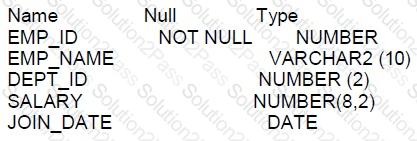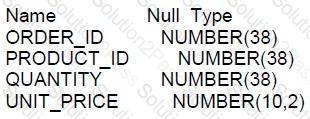1z0-071 Oracle Database 12c SQL Free Practice Exam Questions (2025 Updated)
Prepare effectively for your Oracle 1z0-071 Oracle Database 12c SQL certification with our extensive collection of free, high-quality practice questions. Each question is designed to mirror the actual exam format and objectives, complete with comprehensive answers and detailed explanations. Our materials are regularly updated for 2025, ensuring you have the most current resources to build confidence and succeed on your first attempt.
Which two are true about the precedence of opertors and condtions
Examine the description of the transactions table:
Which two SQL statements execute successfully?
Which three are true about the CREATE TABLE command?
Examine this partial query:
SELECT ch.channel_type, t.month, co.country_code, SUM(s.amount_sold) SALES
FROM sales s, times t, channels ch, countries co
WHERE s.time_ id = t.time id
AND s.country_ id = co. country id
AND s. channel id = ch.channel id
AND ch.channel type IN ('Direct Sales', 'Internet')
AND t.month IN ('2000-09', '2000-10')
AND co.country code IN ('GB', 'US')
Examine this output:

Which GROUP BY clause must be added so the query returns the results shown?
Examine the description of the EMPLOYEES table:

NLS_DATE_FORMAT is set to DD-MON-YY.
Which query requires explicit data type conversion?
Which two statements will return the names of the three employees with the lowest salaries?
Which three statements are true?
Examine the description of the ORDER_ITEMS table:

Examine this incomplete query:
SELECT DISTINCT quantity * unit_price total_paid FROM order_items ORDER BY
Which two can replace
Examine the description of the EMPLOYEES table:

The session time zone is the same as the database server
Which two statements will list only the employees who have been working with the company for more than five years?
Which two are true about the WITH GRANT OPTION clause?
Which three statements are true regarding single row subqueries?
Which two are true about scalar subquery expressions?
Which two statements will return the names of the three employees with the lowest salaries?
SELECT *
FROM bricks,colors;
Which two statements are true?
Which two statements are true about external tables?
Which three statements are true about dropping and unused columns in an Oracle database?
Examine this statement:
SELECT last name
FROM employees
ORDER BY CASE WHEN salary = (SELECT MAX(salary) FROM employees)
THEN ‘A’
ELSE last_ name
END ,last_name DESC;
Which two statements are true?
